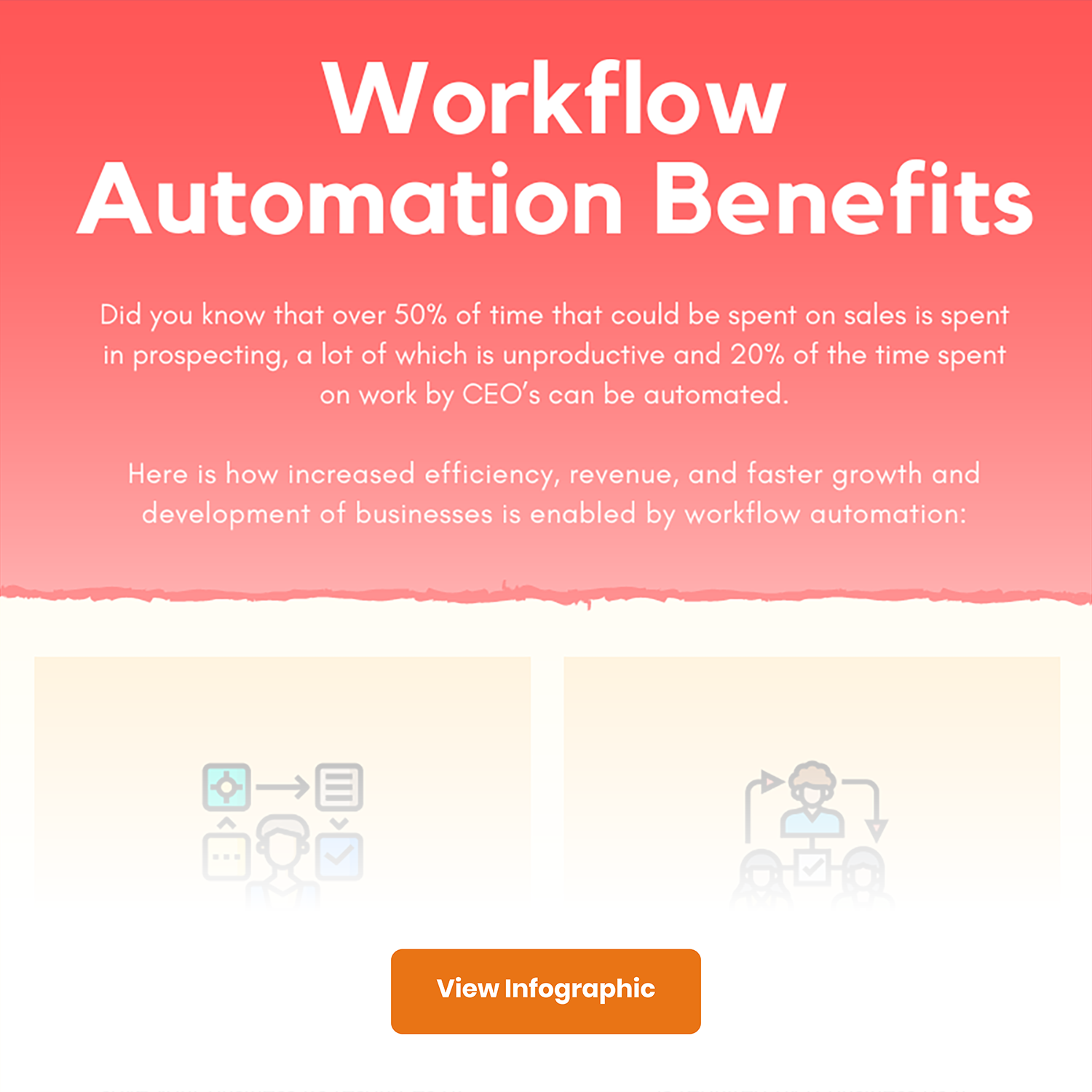
Every process in the industry follows a kind of workflow to get it done effectively. But that workflow was earlier followed by a hardcore manual process which was time-consuming, more exposure to error, and a costly process.
It is exactly like a giant rock standing in the way of the destination, and you have to figure out how to make it easier to reach your goal. Here come the benefits of workflow automation that can remove this giant rock and makes the process easier to perform consecutively.
Adopting workflow automation can offer tremendous advantages to the company’s productivity as well as efficiency. To move on with the help, let us first understand the exact meaning of workflow automation.
What is Workflow Automation?
Workflow automation is a software set that performs specific tasks without human intervention. It makes the course of functions, information, and document-related work activities performed independently per the prescribed business rules and conditions. These business conditions are a sequence of if-else statements that are just instructions for the program to convey which action has to be taken next.
With the proper execution, it follows a detailed schedule in which the tasks are executed consistently to enhance the company’s productivity.
To automate the workflow, the companies initially figure out the tasks to get automated. Secondly, the company’s team generates protocols that control how such studies are executed. Eventually, they build software as per the defined business rules and logic.
Also Read: Complete Guide to Workflow Automation Software
9 Benefits of Workflow Automation
Enterprises are fastly adopting automation for their business processes and IT operations to speed up tasks and enhance communication. Automation reduces manual tasks by inbuilding software that contains drag-and-drop, low code features, and UIs that are easy to adopt. Let us figure out the specific benefits of workflow automation offers to the individual departments of an enterprise.

1. Reduction of errors
The workflow management system has made a big difference in the work done manually and automatically. The employees get so much time after things get automated and made under the control of workflow. It enhances production by reducing the occurrence of errors. Automating workflow can:
- Firstly, prevent the possibility of errors and,
- Secondly, if occurs, it gets us to the exact location of occurrence.
2. Various operations move easily towards task completion
Workflow automation has made things easier for employees. Performing various tasks simultaneously generates the situation of confusion and increases the possibility of errors. However, workflow automation helps businesses to streamline tasks and reduce human efforts.
Time to Assess Automation Feasibility! Let’s use thought-provoking questions to see if it’s a go.
Whether you want to control IT requirements, perform several employee onboarding, request marketing content, conduct internal surveys, or authorize trip reimbursement, everything can be done under a single workflow management system. No need to be bothered by multiple emails, chat tools, etc. Just focus on one flow, and you are done on time.

3. Enhanced collaboration and connectivity
If you are working remotely or hybrid, when most communications go through messages or emails, a pile of pending emails and messages gets created. However, workflow automation tools sought out this problem by keeping a track record of your interactions and organizing them properly.
Workflow management can be molded as per the company’s work ethics to make it goal-driven. Hence, it enables every company employee to streamline processes and work in collaboration to be more productive.
Also Read: 65+ Workflow Automation Statistics and Forecasts you can’t miss!
4. Accelerates transparency, control, and trust
With the acceleration of workflow automation, every task and process is now under control and less overloaded. Employees are much more transparent with their job responsibilities and delighted with fewer manual tasks. They are now capable of building their voluntary skills.
On the other hand, employers feel accessible to envoy ownership throughout the task as trust has been maintained with transparent work ethics using automation. The data accessibility is now entirely under the control of the admin, which cannot be accessed without his permission.
Also Read: 11 Tips to Selecting the Right Workflow Automation Software
5. Improvised business processes
In business processes, workflow automation is involved in data entry operations that dampen human errors, save time, save resources and perform repetitive tasks automatically within minutes. Labor, as well as capital–intensive operations, cannot be scaled reliably by organizations with acquainted manual methods. By introducing workflow automation, businesses have accelerated their potential for scalability.
Workflow automation in business processes also offers benefits like:
- Develops cost-cutting procedures
- The document, as well as approval flows, are also being automated.
- Business process automation dampens the duration of the lifecycle.
- Task management simplified through automation.
Also Read: Workflow Automation and Workflow Management: Difference, Similarities and Importance
6. Enhanced productivity
As automated workflows enable completion of task without human intervention, it leaves a great amount of headspace for employees to work on important things. For example, the employees get so much time after things get automated, and gives them a feeling of satisfaction that they will get error-free results.
Don’t miss out on the benefits of automation. To know your business’ automation status request your personalized Automation Report Card now!
The on-time completion of tasks not only adds to employees productivity but opens a path for company’s overall success.

7. Developers and operations (DevOps)
Automating a workflow clears the path for better releases and transparent lines of communication among developers and operations, two autonomous areas.
It also terminates general barriers between developers and operations, for example, follow-ups and bottlenecks that separate developer and operation channels majorly bring.
8. Automates unnecessary manual tasks
According to the survey conducted by IT Chronicles, repetitive manual task expenses are $5 Trillion per year globally. On calculations, it is predicted that 69 days annually have been spent on these manual tasks, which can be utilized in some other productive exposures if they use workflow systems.
Workflow systems can automate jobs with predefined business perspectives, reducing manual tasks. For instance, approval workflows can process approval-related operations of the organization in significantly less time.
Also Read: Achieving Efficiency Amid Automation Challenges: Expert Tips
9. IT network management
IT workflow automation can generate superior administrative oversight over clouds, operating systems, departmental interactivity, and networks.
Automation can build a crucial visualization sheet for better configuration and identification of the network’s health, deficiencies, and security.
Hence, the above benefits of workflow automation significantly offer your organization quality and rigorous automation facilities. Let us find various workflow automation software streamlining a specific organization field.

Real-life examples of Workflow Automation
You can quickly deploy automation to various kinds of workflow. There exist different compatible software for other departments of the organization. Now you aim to ascertain the best software for different workflows of your organization. Let us get to the bottom of workflow automation software for several areas:
1. Sales
For example, with a no-code workflow automation tool, businesses can automate contract management. You can create a workflow to auto-generate sales contracts based on information captured in CRM and route them for stakeholder reviews and approvals.
2. Marketing
Automated Workflow is efficiently used by Marketing Operations (MOPs) to measure the statistics, perform marketing analysis and marketing campaigns, as well as to maintain a customer communication channel.
3. Manufacturing
- In the company’s manufacturing department, automation workflow is effectively used in managing business structures.
- It mitigates the repetition, if any, and upgrades the quality-control defects.
4. IT System Management
Businesses can create a workflow for employees to raise IT management service requests for any needs or system updates.
5. Finance
Businesses can create automated budget approval workflow and eliminate manual processes. Auto-generated budget requests can be routed to stakeholders for approvals.
Also Read: Workflow Automation in 6 simple steps with No-Code
Who can employ Workflow Automation?
A survey by Zapier reports that 94% of SMB (small and medium-sized business) workers said that manually performing repetitive tasks is highly time-consuming. 90% of knowledge workers said workflow automation enhances their job. Further, 66% reported that automation had built their capability of being highly productive.
Hence, in the organization, every department, including finance, operation & sales, human resource, and marketing, can effectively use a workflow automation system. It will for sure automates monotonous tasks and does not need any decision-making.
Also Read: AI Workflow Automation: A New Era of Streamlined Processes
Implementing Workflow Automation: Tips for Businesses and Why Quixy Makes it Easy
Workflow automation holds immense potential for increased efficiency, productivity, and cost savings. However, successful implementation requires careful planning and execution. Here are some valuable tips for businesses considering taking the plunge:
1. Identify the Right Processes
- Start by evaluating your current workflows. Look for repetitive, time-consuming, or error-prone tasks. These are prime candidates for automation.
- Prioritize high-impact areas. Focus on workflows significantly affecting customer experience, employee productivity, or operational efficiency.
- Gather employee input. Engage your team in the process. Involve them in identifying tasks for automation and gather their feedback on potential changes.
2. Choose the Right Tool
- Consider your technical expertise. User-friendly tools that are perfect for beginners.
- Evaluate your needs. Do you need basic automation or complex process orchestration? Consider features, scalability, and integrations with your existing systems.
- Compare pricing plans. Choose a tool that fits your budget and offers a plan that scales with your needs.
3. Plan and Design
- Map out your workflows. Clearly define the steps, triggers, and actions involved in each process targeted for automation.
- Set realistic goals and expectations. Don’t aim to automate everything at once. Start with a few key workflows and gradually expand.
- Develop clear documentation and communication plans. Ensure your team understands the changes, how automation will work, and their roles in the new workflow.
4. Implement and Test
- Start with a small pilot project. This allows you to test the automation, identify any issues, and refine the process before scaling up.
- Monitor and iterate. Regularly track the performance of your automated workflows. Gather feedback from users and adjust the automation as needed.
- Be prepared for challenges. Technical difficulties, resistance to change, and unforeseen issues can arise. Proactive planning and clear communication can help mitigate these challenges.
5. Continuously Improve
- Seek feedback from your team. Encourage suggestions for further automation opportunities and refine workflows based on user experience.
- Stay updated. New tools with advanced features are constantly emerging. Be open to exploring new options and adapting your approach as needed.
- Embrace the learning curve. Implementing workflow automation is a journey, not a destination. Embrace continuous learning and improvement to optimize your workflows and reap the long-term benefits.
Why Choose Quixy for Your Workflow Automation Journey?
Quixy empowers businesses of all sizes and technical abilities to unlock the power of workflow automation. Here’s what sets Quixy apart:
- No-code low-code platform: Build powerful workflows visually – no coding required.
- Intuitive interface: Easy to use, even for non-technical users, allowing citizen developers to take ownership of automation.
- Scalability and customization: Manage simple or complex workflows with ease, scaling as your needs grow.
- Seamless integrations: Connect with your existing tools and applications, creating a unified ecosystem.
With Quixy, you can streamline your operations, improve collaboration, and achieve your business goals faster.
Conclusion
The coming alterations in the near future are valid as they are in the scope of workflow. The technology will grow and eventually grows workflow automation. There is a need to work on a deepened understanding of the workflows and streamline them with strong insights into the operations shaping the business plans. This can upgrade the workflows to build a smooth working culture between work from home and the hybrid model. Moreover, workflow management tools can foster teamwork and innovation.
Quixy, a no-code workflow automation platform, offers 10X times faster and more reliable workflow automation tools than other traditional services. Most importantly, these tools are scalable and easy to understand. Begin your journey towards streamlined operations and tailored apps – all with the simplicity of our platform. Get started today to harness the potential of automation.
Frequently Asked Questions(FAQs)
What is Workflow Automation, and how can it benefit my business?
Workflow automation is used technology to streamline and automate repetitive tasks, saving time and reducing errors. It benefits businesses by increasing efficiency, productivity, and collaboration.
How does Workflow Automation improve efficiency and save time?
By automating manual tasks, it frees up employees to focus on more strategic and creative work, ultimately increasing overall efficiency and productivity.
What are the benefits of workflows?
Workflows bring structure and efficiency to processes, enabling clear task assignments, smoother collaboration, faster approvals, and better visibility into progress.
What is the main purpose of workflow automation?
The main purpose of automation is to streamline and optimize processes by using technology to automate repetitive tasks, saving time and reducing manual errors.
Can workflow automation help in maintaining compliance and reducing risks?
Yes, it ensures that processes adhere to predefined rules, reducing human error and mitigating risks related to compliance.
Subscribe
Login
Please login to comment
0 Comments
Oldest















